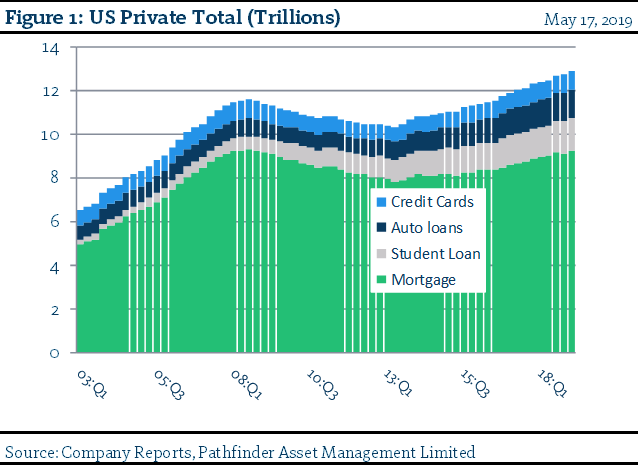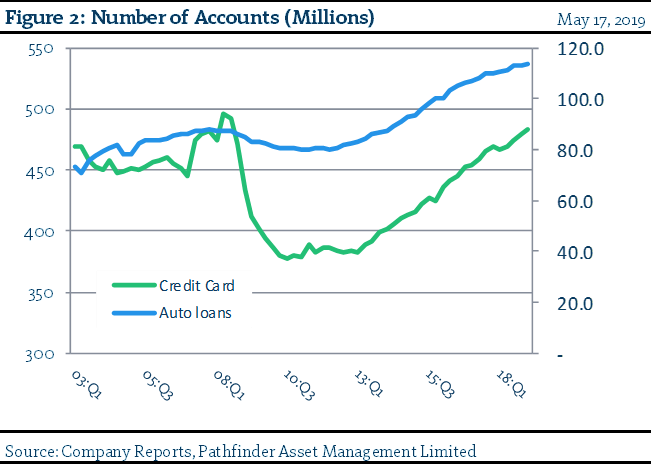Recap & Outlook: US Household Debt
There has been more volatility in financial markets related to the ongoing trade tensions between the United States and China. We view this as a temporary issue that is based more on negotiating tactics than actual long-term negative change in the relationship between these two nations. Most geo-political observers believe that trade should be more balanced and that there should be some better protection for intellectual property. These are the world’s two largest economies and they need each other’s cooperation.
We mention the above because it is topical but in reality, we continue to focus on our individual research on the real economy. This week, we noticed a number of reports with respect to US household debt levels. We have written before about the levels of government debt which, in our opinion, continues to be manageable. Private sector debt, however, is a situation that can change dramatically over time and should be monitored. When consumers take on two much debt, spending at the margin can slow as they work to pay the debt off. This is what ultimately can drive the economic cycle lower.
- As you can see from Figure 1, total debt has grown to US$13.7 trillion with mortgages and student loans crossing peaks last set in 2008. We also note that auto loans and credit card debt “Serious Delinquency Rates” (i.e. 90+ days) have trended up consistently since 2016.

- Figure 2 presents the number of credit card and loan accounts from 2003 through March of this year. As you can see, after a big dip in 2008/09 they have rebounded to prior levels.

“This means that” we will spend more time researching the current debt environment in general (and not just in the United States). We want to determine if debt for various sectors (i.e. personal, corporate and public) continues to be manageable.
National Instrument 31-103 requires registered firms to disclose information that a reasonable investor would expect to know, including any material conflicts with the firm or its representatives. Doug Johnson and/or Pathfinder Asset Management Limited are an insider of companies periodically mentioned in this report. Please visit www.paml.ca for full disclosures.
*All returns are time weighted and net of investment management fees. Returns from the Pathfinder Partners’ Fund and Partners’ Real Return Plus Fund are presented based on the masters series of each fund. The Pathfinder Core: Equity Portfolio and The Pathfinder Core: High Income Portfolio are live accounts. These are actual accounts owned by the Pathfinder Chairman (Equity) and client (High Income) which contain no legacy positions, cash flows or other Pathfinder investment mandates or products. Monthly inception dates for each fund and portfolio are as follows: Pathfinder North American: Equity Portfolio (January 2011), Pathfinder North American: High Income Portfolio (October 2012) Pathfinder Partners’ Fund (April 2011), Pathfinder Real Return Plus Fund (April, 2013), Pathfinder International Fund (November 2014) and Pathfinder Resource Fund (May 2018).
Pathfinder Asset Management Limited (PAML) and its affiliates may collectively beneficially own in excess of 10% of one or more classes of the issued and outstanding equity securities mentioned in this newsletter. This publication is intended only to convey information. It is not to be construed as an investment guide or as an offer or solicitation of an offer to buy or sell any of the securities mentioned in it. The author has taken all usual and reasonable precautions to determine that the information contained in this publication has been obtained from sources believed to be reliable and that the procedures used to summarize and analyze such information are based on approved practices and principles in the investment industry. However, the market forces underlying investment value are subject to sudden and dramatic changes and data availability varies from one moment to the next. Consequently, neither the author nor PAML can make any warranty as to the accuracy or completeness of information, analysis or views contained in this publication or their usefulness or suitability in any particular circumstance. You should not undertake any investment or portfolio assessment or other transaction on the basis of this publication, but should first consult your portfolio manager, who can assess all relevant particulars of any proposed investment or transaction. PAML and the author accept no liability of any kind whatsoever or any damages or losses incurred by you as a result of reliance upon or use of this publication.